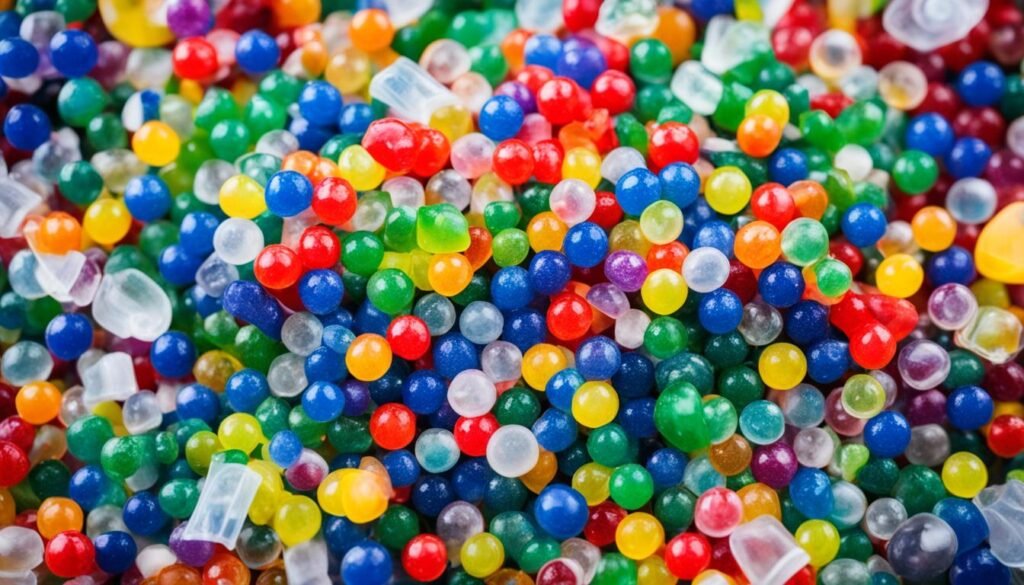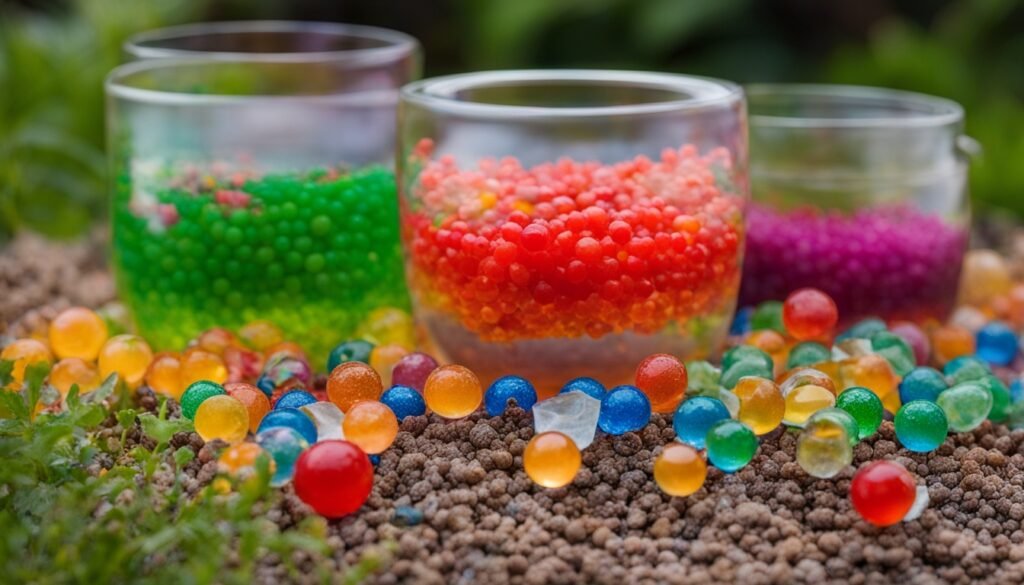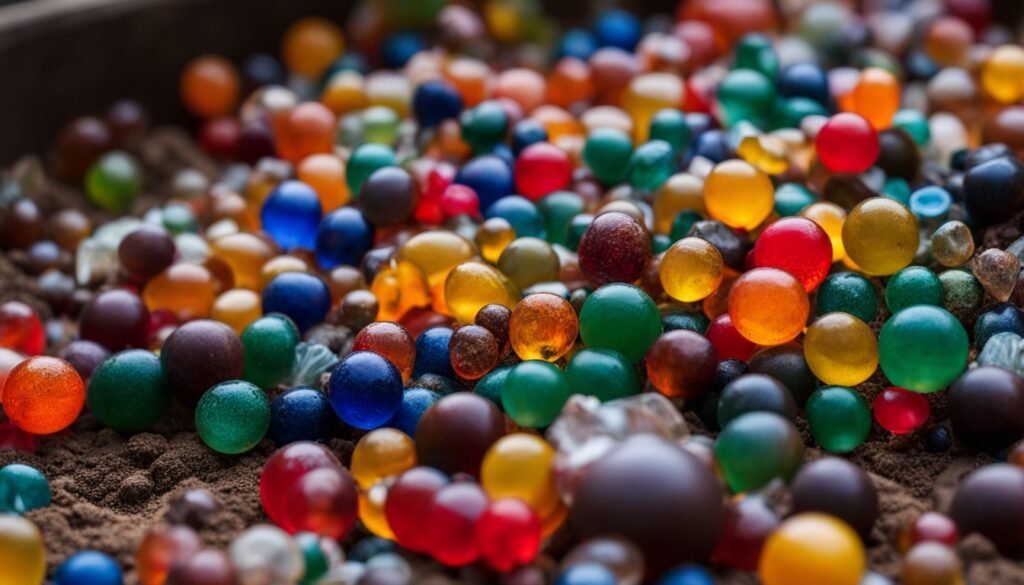Orbeez have gained popularity as sensory toys and decorative items. Many wonder about their environmental impact. This article explores Orbeez’s eco-friendliness and potential harm to the environment.
We’ll uncover the truth about these tiny water beads. We’ll examine their biodegradability and overall environmental effects.
Table of Contents
ToggleKey Takeaways
- Orbeez are made from a superabsorbent polymer called sodium polyacrylate, which is not biodegradable or compostable.
- Orbeez can contribute to clogging and blockages in plumbing systems if disposed of improperly.
- Wildlife may mistake Orbeez for food, leading to ingestion and possible harm.
- Reusing Orbeez by drying them out and storing them for future activities can reduce waste.
- Orbeez are estimated to take hundreds of years to completely degrade without intervention.
What Are Orbeez?
Orbeez: A Closer Look
Orbeez are small polymer spheres that absorb and retain water. They start as tiny hard pellets and expand into gel-like orbs when soaked. These colorful beads are used for sensory play, decoration, and hydroponic gardening.
The main component of Orbeez is sodium polyacrylate, a superabsorbent polymer. It can absorb hundreds of times its weight in water. Fully hydrated, these beads can reach 14 millimeters in diameter.
Orbeez offer a unique sensory experience with their soft, squishy texture. Their vibrant hues make them popular for tactile play, especially among children. They also help maintain soil moisture in hydroponic gardening.
| Orbeez Composition | Orbeez Properties | Orbeez Uses |
|---|---|---|
| Sodium polyacrylate, acrylic acid, sodium hydroxide, water, and color pigments |
|
|
Orbeez fascinate people of all ages with their unique properties. They offer a fun way to explore science and nature. These water beads continue to grow in popularity for sensory and hydroponic experiences.
The Biodegradability of Orbeez
Orbeez aren’t biodegradable or compostable. They don’t break down naturally over time through microorganism action. This raises concerns about their environmental impact.
Are Orbeez Biodegradable?
Orbeez are made from sodium polyacrylate, a synthetic superabsorbent polymer. This material doesn’t easily decompose in the environment. A study in Environmental Science and Pollution Research International found its decay rate extremely slow.
The estimated half-life of sodium acrylate, Orbeez’s main component, ranges from 208 to 416 years. This slow decomposition rate contributes to plastic pollution problems.
Orbeez can persist in the environment for years. Their synthetic nature prevents them from biodegrading at an environmentally friendly rate.
| Material | Biodegradation Rate | Decomposition Timeline |
|---|---|---|
| Orbeez (sodium polyacrylate) | Extremely slow | 208 to 416 years |
| Natural Sponges | Readily biodegradable | Several months |
| Plant-based Alternatives | Highly biodegradable | Weeks to months |
Orbeez’s long decomposition timeline contrasts sharply with biodegradable materials. Natural sponges and plant-based alternatives break down much faster. This difference highlights the need for more sustainable options.
Proper disposal of Orbeez is crucial to minimize ecosystem impact. They can hydrate plants in soil but shouldn’t replace proper care. Consider sustainable alternatives to reduce waste and environmental harm.
Environmental Impact of Orbeez
Orbeez, super-absorbent polymer beads, have gained massive popularity. From 2021 to 2023, about 3.4 million packets were sold. Each pack contains thousands of beads, showing their widespread use.
Orbeez’s non-biodegradable nature is a major issue. Their main component, sodium acrylate, decays very slowly. It could take 208 to 416 years for Orbeez to decay by half.
Improper disposal of Orbeez can clog plumbing systems. In natural water bodies, they persist and may disrupt ecosystems. The UN reports that humans ingest a credit card’s worth of plastic weekly.
Wildlife might mistake Orbeez for food. This can cause internal blockages and harm ecosystems. Their slow decomposition rate, spanning centuries, poses long-term environmental risks.
Orbeez are made from non-toxic polymer but don’t break down naturally. Eco-friendly alternatives exist, like biodegradable water beads made from agar or tapioca. These options offer similar versatility without long-term environmental damage.
| Statistic | Value |
|---|---|
| Orbeez and water beads purchased (Sep 2021 – Jul 2023) | 3.4 million packets |
| Decay rate of sodium acrylate (Orbeez main component) | 0.12% – 0.24% every 6 months |
| Time for Orbeez to decay by half | 208 – 416 years |
| Plastic ingested by humans per week | Credit card worth |
Orbeez and Plastic
Orbeez are made from a polymer-based material, not traditional plastic. Both come from chemical processes and can harm the environment. Sodium polyacrylate, the main ingredient in Orbeez, is a polymer with environmental concerns.
Orbeez expand like a sponge, growing 100 times larger when wet. This happens due to their synthetic polymer compound, similar to plastics. Orbeez contain polyacrylamide, a polymer that doesn’t easily break down.
Though not toxic, Orbeez take time to decompose. Some may show signs of breaking down in two weeks. However, full decomposition can take months or years, depending on conditions.
| Material | Biodegradability | Environmental Impact |
|---|---|---|
| Orbeez (Polyacrylamide) | Slowly Biodegradable | Releases acrylamide, a neurotoxin and carcinogen |
| Plastic | Non-Biodegradable | Accumulates in the environment, harms wildlife |
| Gelatin (Paintballs) | Biodegradable | Relatively low environmental impact |
| Plastic (Airsoft Balls) | Non-Biodegradable | Extremely long decomposition time, harms wildlife |
Orbeez are more eco-friendly than plastics but still pose environmental risks. They break down slowly and release acrylamide, a toxic substance. Consider responsible disposal and using fully biodegradable alternatives to reduce environmental impact.
Orbeez and Water Systems
Orbeez can cause big problems when not disposed of correctly. These water-absorbing beads don’t break down easily. They can clog pipes and drains, leading to orbeez water system contamination and orbeez plumbing issues.
Flushing Orbeez down toilets or drains is harmful. They can build up in sewers and septic tanks. This causes blockages and orbeez water pollution in local waterways.
Orbeez harm aquatic ecosystems, creating orbeez water body impact. Wildlife may mistake them for food, causing choking or digestive problems. These beads can also change water’s pH and oxygen levels, upsetting nature’s balance.
| Issue | Impact |
|---|---|
| Orbeez water system contamination | Clogging of pipes and drainage systems |
| Orbeez plumbing issues | Blockages and backups in sewers and septic systems |
| Orbeez water pollution | Contamination of local waterways |
| Orbeez water body impact | Disruption of aquatic ecosystems and wildlife |
We must dispose of Orbeez responsibly to protect our environment. Collecting and composting the beads is a good method. This helps prevent damage to plumbing and aquatic habitats.
Are Orbeez Biodegradable?
Orbeez, water-absorbing polymer beads, are popular among children and crafters. Many wonder about their environmental impact. Let’s explore whether Orbeez are biodegradable.
Surprisingly, Orbeez are not biodegradable. They’re made of sodium polyacrylate, a synthetic polymer. This material doesn’t break down easily in nature.
Research shows Orbeez have a slow degradation timeline. Their estimated half-life ranges from 208 to 416 years. This means Orbeez can last for centuries in the environment.
Orbeez are non-toxic but their non-biodegradable classification raises concerns. Improper disposal can clog plumbing systems. In natural water bodies, they may harm wildlife.
| Orbeez Biodegradable Properties | Orbeez Biodegradation Timeline |
|---|---|
| Orbeez are primarily made of sodium polyacrylate, a synthetic polymer that does not readily decompose. | The estimated half-life of the sodium polyacrylate in Orbeez ranges from 208 to 416 years, meaning they can persist in the environment for centuries. |
| Orbeez are classified as non-biodegradable, unlike their water-based counterparts, which are considered biodegradable. | Improper disposal of Orbeez, such as flushing them down the toilet or washing them down the drain, can lead to clogging and blockages in plumbing systems. |

We can reduce Orbeez’s environmental impact through responsible practices. Drying and reusing Orbeez helps cut plastic waste. This approach supports a circular economy.
Orbeez and Wildlife
Ecological Impact
Orbeez are fun toys, but they pose risks to the environment. These small, colorful beads can harm animals in both land and water ecosystems.
The main danger of orbeez wildlife impact is animals eating them by mistake. Birds, rodents, and marine life might think Orbeez are food. This can cause health problems or even death for these creatures.
Orbeez animal ingestion can be deadly. These non-biodegradable materials can disrupt natural ecosystems and harm animal health.
- Orbeez can build up in nature, harming the balance of orbeez ecosystem disruption. This threatens the health of native wildlife.
- In water, Orbeez can cause significant orbeez marine life impact. They may hurt aquatic organisms and upset delicate marine ecosystems.
To reduce Orbeez’s environmental impact, makers and users must act responsibly. This includes proper disposal and teaching others about wildlife risks.
We need to learn how Orbeez affect ecosystems. It’s important to preserve nature’s balance for all living things.
“The accumulation of Orbeez in natural habitats can have far-reaching consequences for the delicate balance of ecosystems, ultimately impacting the health and well-being of wildlife.”
Together, we can tackle the orbeez wildlife impact. By promoting eco-friendly options, we can protect nature and ensure a better future.
The Environmental Consciousness of Orbeez
Orbeez, the popular water-absorbing beads, aren’t biodegradable. However, efforts are underway to reduce their environmental impact. Orbeez reuse and recycling align with orbeez circular economy and orbeez sustainable practices.
Reusing Orbeez is an effective solution. After use, dry them out and store for future activities. This extends their lifespan and significantly reduces waste.
Orbeez’s water-absorbing nature makes them versatile. They’re great for sensory play, decorations, and stress balls. This versatility promotes an orbeez environmental consciousness approach.
Despite not being biodegradable, Orbeez’s sustainable practices are promising. The push for reuse and recycling indicates a positive shift. Consumers and manufacturers can work together to reduce waste and promote sustainability.
| Reuse and Recycling of Orbeez | Benefits |
|---|---|
| Drying and storing Orbeez for future use | Extends the lifespan of Orbeez, reduces waste |
| Repurposing Orbeez for sensory play, decorative uses, and stress balls | Promotes orbeez circular economy and orbeez sustainable practices |
| Composting Orbeez as an organic waste management method | Supports plant health and minimizes landfill usage |
The Orbeez community can create a more sustainable future. By adopting orbeez environmental consciousness and orbeez reuse and recycling strategies, we support the orbeez circular economy.

Orbeez Degradation Process
Orbeez are popular water-absorbing beads loved by children. These fascinating spheres are made of sodium polyacrylate, a superabsorbent polymer. This material was first created for farming to help soil keep moisture.
Orbeez’s slow breakdown is great for hydrogel farming. It keeps them working in soil for a long time. But using Orbeez as toys creates a unique problem.
The swelling ability that makes Orbeez fun also makes them non-biodegradable. This means they don’t break down easily in nature.
Why Orbeez Shouldn’t Be Biodegradable
Orbeez aren’t meant to be biodegradable. Their slow decay is key for their use in farming. Orbeez take 208 to 416 years to decay by half.
Their decay rate is only 0.12% – 0.24% every 6 months. This makes them basically non-biodegradable. Orbeez can harm ecosystems and wildlife by staying in nature so long.
The UN says humans eat a credit card’s worth of plastic weekly. This shows the bigger problem of microplastics. As Orbeez break down over centuries, they add to this issue.
Orbeez may be fun, but they last for centuries in nature. They can harm delicate ecosystems and wildlife. We need to dispose of Orbeez responsibly.
Conclusion
Orbeez aren’t truly biodegradable due to their synthetic polymer composition. They contain sodium polyacrylate, which degrades very slowly. The estimated half-life of Orbeez ranges from 208 to 416 years.
Improper disposal of Orbeez can clog water systems and harm wildlife. To reduce their impact, we should reuse them and explore sustainable options. Drying and sealing Orbeez in garbage bags is a responsible disposal method.
Orbeez can be repurposed for soil improvement and sensory play. These creative uses offer alternatives to throwing them away. By being environmentally conscious, we can lessen Orbeez’s long-term effects on nature.
FAQ
Are Orbeez biodegradable?
No, Orbeez are not biodegradable. They’re made from sodium polyacrylate, a synthetic polymer. This material degrades very slowly, with a half-life of 208 to 416 years.
What is the environmental impact of Orbeez?
Improper disposal of Orbeez can clog plumbing systems. They persist in the environment for a long time. If they reach natural water bodies, Orbeez may disrupt ecosystems.
Are Orbeez considered plastic?
Orbeez aren’t conventional plastic, but they’re a polymer-based material. They share similar environmental concerns with plastics due to their non-biodegradable nature.
How can the environmental impact of Orbeez be reduced?
Reusing Orbeez and exploring sustainable alternatives can help reduce their impact. It’s best to dry them out and store them for future use.
Do Orbeez pose a risk to wildlife?
Yes, Orbeez can be harmful to wildlife. Small animals may mistake them for food and eat them. Ingesting these non-biodegradable materials can cause digestive problems or blockages in animals.

